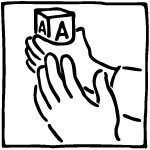








|

Goal 1: Ready to Learn
By the year 2000, all children will start school ready to learn.
Did you know... that between 1990 and 1996, the United states was successful in reducing the proportion of infants born with one or more health risks from 37% to 34% -- representing at least 72,700 children who were born with a healthier start in life?
Objectives:
- Children will receive the nutrition, physical activity experiences, and health care needed to arrive at school with healthy minds and bodies, and to maintain the mental alertness necessary to be prepared to learn, and the number of low-birthweight babies will be significantly reduced through enhanced prenatal health systems.
See national indicators 1, Children's Health Index, and 2, Immunizations, for a review of progress toward this objective.
- Every parent in the United States will be a child's first teacher and devote time each day to helping such parent's preschool child learn, and parents will have access to the training and support parents need.
See national indicator 3, Family-Child Reading and Storytelling, for a review of progress toward this objective.
- All children will have access to high-quality and developmentally appropriate preschool programs that help prepare children for school.
See national indicator 4, Preschool Participation, for more information about progress toward this objective.
The 1999 Goals Report gives special emphasis to state improvement over time. To learn which states have made improvements over time, which states are the top performers, and which are the most improved in the five state measures related to Goal 1, click on the appropriate indicator below.

Goal 2: School Completion
By the year 2000, the high school graduation rate will increase to at least 90 percent.
Did you know... that 2,756 children drop out of high school every school day and that within two years of graduating, high school graduates can expect to earn 25% more than dropouts?
Objectives:
The 1999 Goals Report gives special emphasis to state improvement over time. To learn which states have made improvements over time, which states are the top performers, and which are the most improved in the two state measures related to Goal 2, click on the appropriate indicator below.

Goal 3: Student Achievement and Citizenship
By the year 2000, all students will leave grades 4, 8, and 12 having demonstrated competency over challenging subject matter including English, mathematics, science, foreign languages, civics and government, economics, arts, history, and geography, and every school in America will ensure that all students learn to use their minds well, so they may be prepared for responsible citizenship, further learning, and productive employment in our Nation's modern economy.
Did you know...that in twenty-seven states the percentage of 8th graders who scored at the Proficient or Advanced levels in mathematics on the 1996 National Assessment of Educational Progress (NAEP) increased?
Objectives:
- The academic performance of all students at the elementary and secondary level will increase significantly in every quartile, and the distribution of minority students in each quartile will more closely reflect the student population as a whole.
Seven indicators show student achievement for grades 4, 8, and 12 in reading, writing, mathematics, science, civics, history, and geography. Select an area of achievement to review these results.
- The percentage of all students who demonstrate the ability to reason, solve problems, apply knowledge, and write and communicate effectively will increase substantially.
- All students will be involved in activities that promote and demonstrate good citizenship, good health, community service, and personal responsibility.
- All students will have access to physical education and health education to ensure they are healthy and fit.
- The percentage of all students who are competent in more than one language will substantially increase.
- All students will be knowledgeable about the diverse cultural heritage of this Nation and about the world community.
The 1999 Goals Report gives special emphasis to state improvement over time. To learn which states have made improvements over time, which states are the top performers, and which are the most improved in the five state measures related to Goal 3, click on the appropriate indicator below.

Goal 4: Teacher Education and Professional Development
By the year 2000, the Nation's teaching force will have access to programs for the continued improvement of their professional skills and the opportunity to acquire the knowledge and skills needed to instruct and prepare all American students for the next century.
Did you know...that between 1991 and 1994, the percentage of secondary school teachers who held an undergraduate or graduate degree in their main teaching assignment decreased from 66% to 63%? And that in 1994, only about half of all teachers reported having any professional development in the use of educational technology and in student assessment strategies in the previous year, despite rapidly changing knowledge and practice in those areas?
Objectives:
- All teachers will have access to preservice teacher education and continuing professional development activities that will provide such teachers with the knowledge and skills needed to teach to an increasingly diverse student population with a variety of educational, social, and health needs.
See national indicator 13,
Teacher Preparation,
for the percentage of secondary school teachers who hold an undergraduate or graduate degree in their main teaching assignment.
- All teachers will have continuing opportunities to acquire additional knowledge and skills needed to teach challenging subject matter and to use emerging new methods, forms of assessment, and technologies.
See national indicator 14,
Teacher Professional Development,
for the percentage of teachers who reported participation in in-service or professional development programs.
- States and school districts will create integrated strategies to attract, recruit, prepare, retrain, and support the continued professional development of teachers, administrators, and other educators, so that there is a highly talented work force of professional educators to teach challenging subject matter.
- Partnerships will be established, whenever possible, among local educational agencies, institutions of higher education, parents, and local labor, business, and professional associations to provide and support programs for the professional development of educators.
The 1999 Goals Report gives special emphasis to state improvement over time. To learn which states have made improvements over time, which states are the top performers, and which are the most improved in the five state measures related to Goal 4, click on the appropriate indicator below.

Goal 5: Mathematics and Science
By the year 2000, United States students will be the first in the world in mathematics and science achievement.
Did you know...that in a recent research study which used National Assessment of Educational Progress (NAEP) mathematics and science scores to predict how states would perform relative to the 41 nations that participated in the Third International Mathematics and Science Study (TIMSS), 14 states would be expected to reach world-class levels of performance in science?
Objectives:
- Mathematics and science education, including the metric system of measurement, will be strengthened throughout the system, especially in the early grades.
See national indicator 15, International Mathematics Achievement, which shows the U.S. standing in Grades 4, 8, and 12 on international mathematics assessments, and national indicator 16, International Science Achievement, which shows the U.S. standing in Grades 4, 8, and 12 on international science assessments.
- The number of teachers with a substantive background in mathematics and science, including the metric system of measurement, will increase by 50 percent.
- The number of United States undergraduate and graduate students, especially women and minorities, who complete degrees in mathematics, science, and engineering will increase significantly.
See national indicator 17, Mathematics and Science Degrees,
showing the percentage of Bachelor's degrees in mathematics and science as a percentage of all degrees awarded to all students, minorities, and females.
The 1999 Goals Report gives special emphasis to state improvement over time. To learn which states have made improvements over time, which states are the top performers, and which are the most improved in the nine state measures related to Goal 5, click on the appropriate indicator below.

Goal 6: Adult Literacy and Lifelong Learning
By the year 2000, every adult American will be literate and will possess the knowledge and skills necessary to compete in a global economy and exercise the rights and responsibilities of citizenship.
Did you know...that fewer adults with a high school diploma or less are participating in adult education, compared to those who have post secondary education? And that for both young men and young women, employment rates were higher for college graduates than for those with only a high school diploma or GED?
Objectives:
- Every major American business will be involved in strengthening the connection between education and work.
- All workers will have the opportunity to acquire the knowledge and skills, from basic to highly technical, needed to adapt to emerging new technologies, work methods, and markets through public and private educational, vocational, technical, workplace, or other programs.
See national indicator 18,
Adult Literacy,
for the percentage of adults who are likely to be able to perform complex literacy tasks.
- Schools, in implementing comprehensive parent involvement programs, will offer more adult literacy, parent training and lifelong learning opportunities to improve the ties between home and school, and enhance parents' work and home lives.
See national indicator 19,
Participation in Adult Education,
for the disparities between adults with a high school diploma or less and those with additional education.
- The number of quality programs, including those at libraries, that are designed to serve more effectively the needs of the growing number of part-time and midcareer students will increase substantially.
- The proportion of qualified students, especially minorities, who enter college, who complete at least two years, and who complete their degree programs will increase substantially.
See national indicator 20,
Participation in Higher Education,
for the disparities in college enrollment and college completion between White and minority high school graduates.
- The proportion of college graduates who demonstrate an advanced ability to think critically, communicate effectively, and solve problems will increase substantially.
The 1999 Goals Report gives special emphasis to state improvement over time. To learn which states have made improvements over time, which states are the top performers, and which are the most improved in the four state measures related to Goal 6, click on the appropriate indicator below.

Goal 7: Safe, Disciplined, and Alcohol- and Drug-Free Schools
By the year 2000, every school in the United States will be free of drugs, violence and the unauthorized presence of firearms and alcohol and will offer a disciplined environment conducive to learning.
Did you know...that threats and injuries to students at school decreased over a 6-year period?
Objectives:
- Every school will implement a firm and fair policy on use, possession, and distribution of drugs and alcohol.
See national indicator 21,
Overall Student Drug and Alcohol Use, for the percentage of 10th graders who reported using any illicit drug, and percentage who reported using alcohol.
- Parents, businesses, governmental and community organizations will work together to ensure the rights of students to study in a safe and secure environment that is free of drugs and crime, and that schools provide a healthy environment and are a safe haven for all children.
See national indicator 22,
Sale of Drugs at School,
for the percentage of 10th graders who reported that someone offered to sell or give them an illegal drug at school.
- Every local educational agency will develop and implement a policy to ensure that all schools are free of violence and the unauthorized presence of weapons.
See national indicator 23,
Student and Teacher Victimization, which shows the percentage of 10th graders and public school teachers who reported that they were threatened or injured.
See national indicator 24,
Disruption in Class by Students,
which provides the percentage of 10th graders who reported that misbehavior by other students interfered with their own learning, and the percentage of teachers who reported that student misbehavior interfered with their teaching.
- Every local educational agency will develop a sequential, comprehensive kindergarten through twelfth grade drug and alcohol prevention education program.
Drug and alcohol curriculum should be taught as an integral part of sequential, comprehensive health education.
- Community-based teams should be organized to provide students and teachers with needed support.
- Every school should work to eliminate sexual harassment.
The 1998 Goals Report gives special emphasis to state improvement over time. To learn which states have made improvements over time, which states are the top performers, and which are the most improved in the nine state measures related to Goal 7, click on the appropriate indicator below.

Goal 8: Parental Participation
By the year 2000, every school will promote partnerships that will increase parental involvement and participation in promoting the social, emotional, and academic growth of children.
Did you know...that a growing body of research suggests that increased family involvement is associated with higher mathematics and reading scores, decreased likelihood that a student will be suspended or expelled from school, and greater student participation in extracurricular school activities? Did you also know that parental involvement in school declines as children get older?
Objectives:
- Every State will develop policies to assist local schools and local educational agencies to establish programs for increasing partnerships that respond to the varying needs of parents and the home, including parents of children who are disadvantaged or bilingual, or parents of children with disabilities.
- Every school will actively engage parents and families in a partnership which supports the academic work of children at home and shared educational decision making at school.
See national indicator 25, Schools' Reports of Parent Attendance at Parent-Teacher Conferences, for the percentage of K-8 public schools which reported that more than half of their parents attended parent-teacher conferences during the school year.
See national indicator 26, Schools' Reports of Parent Involvement in School Policy Decisions, for the percentage of K-8 public schools which reported that parent input is considered when making policy decisions.
See national indicator 27, Parents' Reports of Their Involvement in School Activities, for the percentage of students in Grades 3-12 whose parents reported that they participated in two or more activities in their child's school during the current school year.
- Parents and families will help to ensure that schools are adequately supported and will hold schools and teachers to high standards of accountability.
The 1999 Goals Report gives special emphasis to state improvement over time. To learn which states have made improvements over time, which states are the top performers, and which are the most improved in the five state measures related to Goal 8, click on the appropriate indicator below.
|












